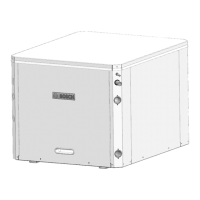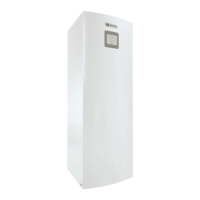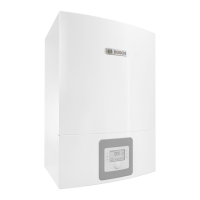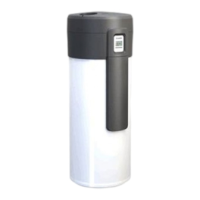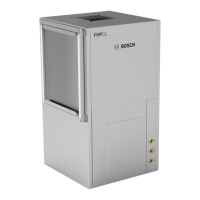Gas safety warnings (R32)
CS3000 AWP – 6721852570 (2023/04)
64
Table 58
10 Gas safety warnings (R32)
Area checks
Please perform safety checks before working on systems containing
refrigerants, in order to reduce the risk of combustion. Before
performing any reparation operations on the cooling system, comply
with the following warnings.
Work procedures
In order to reduce the risk of flammable gases or vapours developing,
operations must be performed following a controlled procedure.
Check the presence of refrigerant
The area must be monitored, before and during operations, with a
dedicated refrigerant detector to make sure the technician is aware of
the presence of potentially-flammable environments.
Make sure the leak detection equipment is suitable for use with
flammable refrigerants and therefore without sparks, suitably sealed or
intrinsically safe.
Work procedures
Regarding the nature of the intervention, all the personnel in charge with
maintenance operations and other operators working in the local area,
must be instructed and monitored.
Avoid working in tight spaces and make sure the area surrounding the
working space is cordoned off. Also secure the area by monitoring the
flammable material.
Presence of the fire extinguisher
If hot interventions are not performed on cooling equipment or
connected components, suitable fire fighting equipment must be kept at
hand.Keep a dry-powder or CO2 extinguisher near the working area.
No ignition source
It is absolutely forbidden to use ignition sources that may lead to fire or
explosion during operations on the refrigerant system or on pipes that
contain or have contained flammable refrigerant.
All possible ignition sources (including cigarettes), must be kept
sufficiently away from the installation, reparation, removal and disposal
site as flammable refrigerant may be released in the surrounding area.
Before starting operations, the area surrounding the equipment must be
inspected to guarantee the absence of flammables or combustion risks.
“SMOKING IS FORBIDDEN” signs must be affixed.
Ventilated area
Before intervening on the system or performing any repairs with flames
or ignition sources, make sure to be in an outdoor or suitably ventilated
area.
Be sure to maintain the ventilation during the operations. Ventilation
must disperse the released refrigerant safely, preferably outdoors in the
atmosphere.
Refrigerant equipment checks
If a replacement is necessary, the new components installed must be
suitable for the purpose envisaged and compliant with specifications.
Always follow the manufacturer guidelines on maintenance and
assistance. In case of doubt, contact the manufacturer technical office
for assistance.
The following checks must be preformed on systems containing
flammable refrigerants:
• The machine and ventilation intake, function correctly and are not
obstructed;
• If an indirect refrigerant circuit is used, the secondary circuits must
be checked to verify the presence of refrigerants; the marking on the
equipment remains visible and readable;
• Make sure markings and symbols are always readable; pipes or
components must be installed in a position that makes improbable
their exposure to substances that may corrode the components
containing refrigerant, unless they are manufactured with material
intrinsically resistant to corrosion or suitably protected against
corrosion.
Electrical device checks
The reparation and maintenance of electric components must include
initial safety checks and component inspection procedures.
In case of a fault that compromises safety, do not perform any electrical
connection to the circuit until said fault is suitably resolved.
If it is not possible to repair the fault immediately and electrical
components need to remain functioning, a temporary solution must be
adopted. This must be reported to the owner of the equipment so as to
keep all parties informed.
Initial safety checks must confirm:
• That electrical condensors are empty. Wait at least 10 minutes after
disconnect the main power. This operation must be performed safely
to avoid any sparks;
• That electrical components and wiring are not exposed during the
charging, recovering or venting phases;
• That the earth conductor is continuous.
Repairing sealed components
• During the operations of reparation of sealed components
disconnect all the equipment before removing sealed casings etc. If,
during operations, it is absolutely necessary for the equipment to
remain connected, place a leak detection device in the most critical
point so as to report any potentially-dangerous situation;
• Pay particular attention to what follows to guarantee that, while
intervening on electrical components, the housing is not altered in a
way so as to affect the level of protection. This includes damage to
cables, an excessive number of connections, terminals not
compliance with the original specifications, damage to gaskets, an
unsuitable installation of gaskets, etc.;
• Make sure the device is installed safely;
• Check that the seals or sealing materials are not altered in such a way
that they no longer the impede the entry of flammable environments.
Spare parts must comply with manufacturer specifications.
Using silicone sealants may inhibit the effectiveness of a few types of
leak detection equipment. It is not necessary to isolate intrinsically safe
components before performing operations on them.
Reparation of intrinsically safe components
Do not apply permanent inductive or capacitive loads to the circuit
without making sure that they do not exceed the admissible voltage and
current allowed for equipment in use.
Intrinsically safe components are the only component type on which
operations can be performed in a flammable atmosphere. The testing
device must show a correct value. Replace components only with the
parts specified by the manufacturer.
Following a leak, other parts could lead to the combustion of the
refrigerant in the atmosphere.
Wires
Make sure wires are not subjected to wear, corrosion, excessive pressure
or vibration, that there are no sharp edges and that they do not produce
other negative effects on the environment. The inspection must also
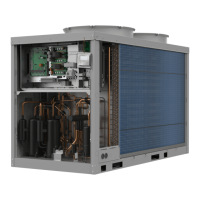
